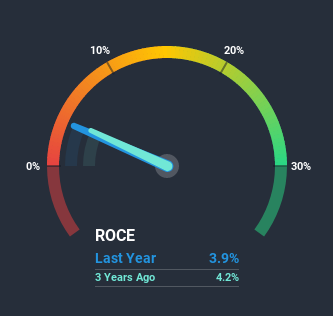Returns On Capital At Daiken (TYO:5900) Paint An Interesting Picture

To find a multi-bagger stock, what are the underlying trends we should look for in a business? In a perfect world, we'd like to see a company investing more capital into its business and ideally the returns earned from that capital are also increasing. This shows us that it's a compounding machine, able to continually reinvest its earnings back into the business and generate higher returns. In light of that, when we looked at Daiken (TYO:5900) and its ROCE trend, we weren't exactly thrilled.
Return On Capital Employed (ROCE): What is it?
For those who don't know, ROCE is a measure of a company's yearly pre-tax profit (its return), relative to the capital employed in the business. To calculate this metric for Daiken, this is the formula:
Return on Capital Employed = Earnings Before Interest and Tax (EBIT) ÷ (Total Assets - Current Liabilities)
0.039 = JP¥481m ÷ (JP¥15b - JP¥2.3b) (Based on the trailing twelve months to August 2020).
Thus, Daiken has an ROCE of 3.9%. Ultimately, that's a low return and it under-performs the Building industry average of 8.6%.
See our latest analysis for Daiken

While the past is not representative of the future, it can be helpful to know how a company has performed historically, which is why we have this chart above. If you'd like to look at how Daiken has performed in the past in other metrics, you can view this free graph of past earnings, revenue and cash flow.
What Can We Tell From Daiken's ROCE Trend?
Over the past five years, Daiken's ROCE and capital employed have both remained mostly flat. This tells us the company isn't reinvesting in itself, so it's plausible that it's past the growth phase. With that in mind, unless investment picks up again in the future, we wouldn't expect Daiken to be a multi-bagger going forward.
What We Can Learn From Daiken's ROCE
In a nutshell, Daiken has been trudging along with the same returns from the same amount of capital over the last five years. Since the stock has gained an impressive 46% over the last five years, investors must think there's better things to come. But if the trajectory of these underlying trends continue, we think the likelihood of it being a multi-bagger from here isn't high.
One final note, you should learn about the 2 warning signs we've spotted with Daiken (including 1 which is doesn't sit too well with us) .
While Daiken may not currently earn the highest returns, we've compiled a list of companies that currently earn more than 25% return on equity. Check out this free list here.
When trading Daiken or any other investment, use the platform considered by many to be the Professional's Gateway to the Worlds Market, Interactive Brokers. You get the lowest-cost* trading on stocks, options, futures, forex, bonds and funds worldwide from a single integrated account. Promoted
New: Manage All Your Stock Portfolios in One Place
We've created the ultimate portfolio companion for stock investors, and it's free.
• Connect an unlimited number of Portfolios and see your total in one currency
• Be alerted to new Warning Signs or Risks via email or mobile
• Track the Fair Value of your stocks
This article by Simply Wall St is general in nature. It does not constitute a recommendation to buy or sell any stock, and does not take account of your objectives, or your financial situation. We aim to bring you long-term focused analysis driven by fundamental data. Note that our analysis may not factor in the latest price-sensitive company announcements or qualitative material. Simply Wall St has no position in any stocks mentioned.
*Interactive Brokers Rated Lowest Cost Broker by StockBrokers.com Annual Online Review 2020
Have feedback on this article? Concerned about the content? Get in touch with us directly. Alternatively, email editorial-team@simplywallst.com.
About TSE:5900
DaikenLtd
Manufactures and supplies various metal products primarily in Japan.
Flawless balance sheet very low.
Similar Companies
Market Insights
Community Narratives




